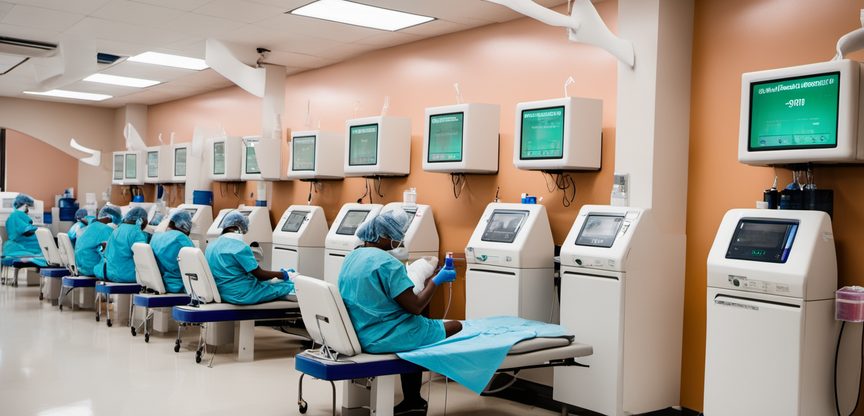The Price of Plasma on Low-Income Canadians
- 7 mins
Recently in Alberta, there have been changes in the laws surrounding plasma donation, allowing private companies to pay individuals for their donations. On the surface, this may seem like a fair deal, where people are compensated for their time and effort. However, the situation is not as clear-cut and ethical as it appears.
Tany Yao, the UCP candidate for Fort McMurray - Wood Buffalo, was the one who spearheaded the repeal of the bill banning paid plasma donation. However, this move hasn't been without controversy. There's irony in his mentioning of China's organ harvesting practices while mischaracterizing Trudeau's comment that "blood is a public resource." In response to Yao's comments, the NDP health critic, David Shepherd, essentially portrayed Yao as an incompetent MLA who spouts nonsense. Such an assessment seems fair, considering Yao's tendency to follow typical alt-right messaging, including comparing the liberal government to Venezuela and accusing labor groups like CUPE of aspiring to be like China.

Ethical Debate
While blood donations receive widespread attention, plasma donation often flies under the radar. The question of whether plasma and blood donors should be compensated has been a topic of debate among ethicists. While there is nothing inherently wrong with compensating donors, the concern arises when monetary incentives become the primary motivation for donating, overshadowing altruism. As a result, donors might be more inclined to deceive during health screening tests, leading to contaminated samples that may carry diseases such as HIV and hepatitis. Though technology can help filter out contaminated samples, the risk of contamination still exists. Additionally, a coercive element can come into play, where low-income individuals may feel compelled to risk their health for financial survival. Even though plasma donation mainly involves the extraction of plasma with the blood returned to the donor, there remains a health risk associated with the process.
Interestingly, the social and ethical concerns of paid plasma donation have been largely absent from conservative critics' arguments against the NDP's opposition to paid donation. Advocates of paid donation, like David Clement, focus on improved safety and resolving the shortage. However, they fail to consider the potential encroachment on the existing non-profit system, the power imbalances affecting desperate donors, or the lack of oversight in private facilities. The introduction of paid donations opens the door to a slippery slope, creating room for conflicts of interest that could jeopardize donor safety.

Health Risks
A 2010 study comparing plasma levels in the USA and Europe found that the quality of plasma in the USA was lower, attributed to the frequency of plasma donation and the risk status of the donors. The high frequency of donation put donors at greater risk because their bodies did not have sufficient time to produce optimal levels of plasma within a week. Further studies are needed, but the differences observed were stark and notable due to various techniques and frequencies.
It's worth noting that blood donations undergo stricter testing, as almost all donations are directly given to recipients. In contrast, plasma is often broken down into components for use in drug formulation, with only a relatively small percentage used for direct transfusions. As technology advances, the risks associated with plasma donation are likely to decrease. However, risks are not limited to donors; we must also consider the cost-saving measures that for-profit sites might employ. With a responsibility to their shareholders, these companies may constantly clash with regulators seeking stricter safety regulations and lobbyists attempting to loosen regulations. Striking the right balance is crucial; while incentivizing more donations and reducing barriers is essential, we must be cautious about profit-driven donation motives that could lead to conflicts of interest and corner-cutting.
History of Tissue Donation
Given the significance of the issue, why hasn't the federal government intervened? To understand the history of organ and tissue donation regulation, a uniform legislation was proposed to regulate non-generative tissue and prohibit its sale. Generative tissue, such as blood and blood constituents, was excluded due to its established practice of donation and sale. Most provinces, including Alberta, adopted this uniform legislation. While there have been amendments and debates over the years concerning reproductive tissue, blood donation regulations have remained consistent.

In 2017, Alberta passed a bill banning private organizations from setting up paid plasma donation centers. Despite around 70-80% of Canada's plasma demand being supplied by international sources, mainly the USA, costing approximately $200 million in 2016, the bill was repealed after the UCP took over, largely influenced by lobbying efforts from Canadian Plasma Resources and the Plasma Protein Therapeutics Association. The latter group represents for-profit manufacturers of plasma protein therapies.
Lobbying itself isn't inherently negative, as it occurs across the political spectrum. However, for-profit companies like Canadian Plasma Resources have a vested interest and substantial financial incentive to push for the repeal of the bill. For these companies, the cost of a single paid sample is only $100 for overhead expenses, while they can sell the plasma to drug manufacturers for as much as $500. Numerous activists and medical groups, including the Canadian Federation of Nurses Union, have voiced their concerns about the privatization of blood and plasma services. Within Canada's medical community, there has been a widespread consensus regarding the ethical issues surrounding paid plasma donations.
Plasma Shortage
Now, one might wonder whether these paid donation centers would help alleviate Alberta's plasma shortage. The CEO of Canadian Blood Services, Dr. Graham Sher, believes that paid plasma donations won't necessarily solve the shortage. Furthermore, there is no guarantee that the plasma collected by Canadian Plasma Resources will even remain in Canada; they could sell it directly to American companies, undermining the efforts of non-profit donation centers. Paid donation, therefore, may not be the ultimate solution to ending the shortage. Alternative approaches, such as giving donors a choice in charitable donation or providing gift cards that cannot be converted to cash, should be considered. A multi-pronged approach involving media awareness and stricter regulations on for-profit collection centers might hold the key to resolving this issue.

Regarding the safety of for-profit companies operating under provincial regulations, it is not a given that these companies are entirely safe. In Alberta, individuals can donate up to two times per week, similar to American guidelines, adding up to 104 times per year. However, in Europe, this number drastically decreases to half, and in places like Korea, individuals can donate only once every other week. The Government of Canada has a page addressing facts and myths about paid plasma donations, but their explanation may not be entirely reassuring. The paragraph near the end addressing fears about using plasma from paid donors focuses on the demand issues rather than the health issues of donors, implying that the risk of unmet demand is seen as a greater concern than the social and ethical aspects of plasma donation.
In Calgary, there exists a for-profit organization called Canadian Plasma Resources, operating in the NE quadrant. This location choice seems reasonable, given the lower cost of rent and its proximity to lower-income Calgarians. During my visit there to donate plasma, it became evident who the target demographic of this operation was. I strongly suspect that the vast majority of donors are from the middle to lower class. In fact, a recent study has shown a significant correlation between poverty and the prevalence of plasma centers, with such centers being more common in economically disadvantaged areas. Furthermore, an increase in plasma centers has been observed around campuses with a higher percentage of low-income student populations. To validate this study's findings, more research should be conducted in Canada.

Raising Awareness
The initial stride in safeguarding the health of Canadians begins with raising awareness. Matters like paid plasma donation may be easily overlooked, but it's a vital issue that could establish a dangerous precedent for the erosion of our public healthcare system. It's time we address health issues through a social and ethical lens. Unfortunately, conservatives often simplify healthcare discussions to mere demand and supply arguments, neglecting to comprehend the social implications and unintended consequences of privatization. This isn't to imply that privatization is inherently negative, but privatization without proper regulation reflects pure laziness and ignorance.
For a more detailed analysis of this situation, please check out Anne Kingston’s article on Maclean’s.

